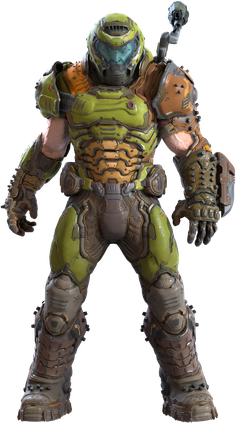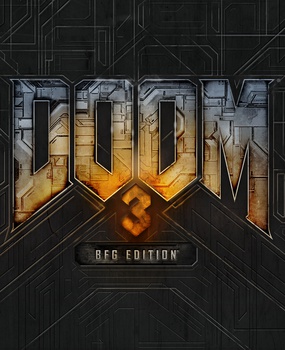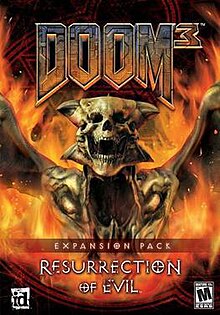
Doom is a first-person shooter game developed and published by id Software. Released on December 10, 1993, for DOS, it is the first installment in the Doom franchise. The player assumes the role of a space marine, later unofficially referred to as Doomguy, fighting through hordes of undead humans and invading demons. The game begins on the moons of Mars and finishes in hell, with the player traversing each level to find its exit or defeat its final boss. It is an early example of 3D graphics in video games, and has enemies and objects as 2D images, a technique sometimes referred to as 2.5D graphics.

Duke Nukem 3D is a first-person shooter video game developed by 3D Realms. It is a sequel to the platform games Duke Nukem and Duke Nukem II, published by 3D Realms.

Heretic is a dark fantasy first-person shooter video game released in December 1994. It was developed by Raven Software and published by id Software through GT Interactive.

Quake is a first-person shooter game developed by id Software and published by GT Interactive. The first game in the Quake series, it was originally released for MS-DOS, Microsoft Windows, and Linux in 1996, followed by Mac OS and Sega Saturn in 1997 and Nintendo 64 in 1998. In the game, players must find their way through various maze-like, medieval environments while battling monsters using an array of weaponry. Quake takes inspiration from gothic fiction and the works of H. P. Lovecraft.

Doom 3 is a 2004 survival horror first-person shooter video game developed by id Software and published by Activision. Doom 3 was originally released for Microsoft Windows on August 3, 2004, adapted for Linux later that year, and ported by Aspyr Media for Mac OS X in 2005. Developer Vicarious Visions ported the game to the Xbox, releasing it worldwide on April 4, 2005.

Doom II, also known as Doom II: Hell on Earth, is a first-person shooter game in the Doom franchise developed by id Software. It was released for MS-DOS in 1994 and Macintosh in 1995. Unlike the original Doom, which was initially only available through shareware and mail order, Doom II was sold in stores.

Final Doom is a first-person shooter video game developed by TeamTNT, and Dario and Milo Casali, and was released by id Software and distributed by GT Interactive in 1996. It was released for MS-DOS and Macintosh computers, as well as for the PlayStation, although the latter featured a selection of levels from Final Doom and from Master Levels for Doom II.

S.T.A.L.K.E.R.: Shadow of Chernobyl is a first-person shooter survival horror video game developed by GSC Game World and published by THQ in 2007 following a long development. The game is set in an alternative reality, where a second disaster of mysterious origin occurred at the Chernobyl Exclusion Zone, causing strange changes in the area around it. The game features a non-linear storyline and includes role-playing gameplay elements such as trading and two-way communication with non-player characters.

Doom 64 is a first-person shooter game by Midway. It was first released for the Nintendo 64 in 1997, as the second spin-off game in the Doom series after Final Doom (1996), and the fourth game in the series overall. A remastered port was developed by Nightdive Studios and published by Bethesda Softworks for Nintendo Switch, PlayStation 4, Windows, and Xbox One in March 2020, and for Stadia in May 2020.

Doomguy is the protagonist of the Doom game series by id Software. He was created by American video game designer John Romero and was introduced as the player character in the original 1993 video game Doom. Within the Doom series, Doomguy is a demon hunter space marine dressed in green combat armor who rarely speaks onscreen, and his personality and backstory were intentionally vague to reinforce his role as a player avatar. In Doom Eternal, he is voiced by American voice actor Matthew Waterson, while Jason Kelley voices the character in that game's downloadable content The Ancient Gods: Part Two, and was portrayed by Karl Urban in the 2005 film adaptation. He has appeared in several other games developed by id Software, including Quake Champions and Quake III Arena.

Hellboy: The Science of Evil is a video game adapted from the 2004 Hellboy film by Guillermo del Toro, based on the comic book character of the same name. It was released for the PlayStation 3, Xbox 360 and PlayStation Portable on June 24, 2008, in North America, followed by an August 15 release in Europe and August 22 release in Australia.

Overlord is an action role-playing video game developed by Triumph Studios and published by Codemasters for Xbox 360, Microsoft Windows, Linux and PlayStation 3. It was released in 2007 in North America on 26 June, in Europe on 29 June and Australia on 6 July.

Doom is a 2016 first-person shooter video game developed by id Software and published by Bethesda Softworks. The game is the first major installment in the Doom series since 2004's Doom 3 and was a reboot of the franchise. It was released for PlayStation 4, Windows, and Xbox One In May 2016. A port for Nintendo Switch was co-developed with Panic Button and released in November 2017, and a version for Google Stadia was released in August 2020. Players take the role of an unnamed space marine, known as the "Doom Slayer", as he battles demonic forces within an energy-mining facility on Mars and in Hell.

A gravity gun is a type of device in video games, particularly first-person shooters using physics engines, whereby players can directly manipulate objects in the world, often allowing them to be used as projectiles against hostile characters. The concept was popularized by the gravity gun found in Valve's Half-Life 2, as well as the Temporal Uplink found in Free Radical Design's TimeSplitters: Future Perfect; although a similar concept was used by id Software during the production of the earlier game Doom 3, eventually leading to the introduction of a physics-based weapon in the expansion pack Resurrection of Evil. Later games, such as Portal, BioShock, Crysis, Dead Space, and Garry's Mod have been influenced by the success of these physics-based weapons, adopting their own styles of comparable abilities or weapons.

Diablo is an action role-playing dungeon crawler video game series developed by Blizzard North and continued by Blizzard Entertainment after the North studio shut down in 2005. The series is made up of four core games: Diablo, Diablo II, Diablo III, and Diablo IV. Expansions include the third-party published Hellfire, which follows the first game; Lord of Destruction, published by Blizzard and released after the second game; and Reaper of Souls, which follows the third game. Additional content is provided through story elements explored in other types of media forms.

Doom is an American media franchise created by John Carmack, John Romero, Adrian Carmack, Kevin Cloud, and Tom Hall. The series usually focuses on the exploits of an unnamed space marine operating under the auspices of the Union Aerospace Corporation (UAC), who fights hordes of demons and the undead to save Earth from an apocalyptic invasion.

Doom 3: BFG Edition is a remastered version of Doom 3, which released on October 16, 2012 in North America and on October 19, 2012 in Europe for Microsoft Windows, PlayStation 3, and Xbox 360. The BFG Edition features enhanced graphics, better audio, a checkpoint save system, and support for 3D displays and head-mounted displays (HMD). The game also includes the previous expansion, Resurrection of Evil, and a new single-player expansion pack called The Lost Mission. Additionally, it includes copies of the original Doom, and Doom II which includes a second episode: No Rest for the Living, which was previously available for the Xbox 360. The BFG Edition also features the ability to use the flashlight while holding a weapon, in the form of the armor-mounted flashlight.

Doom Eternal is a 2020 first-person shooter game developed by id Software and published by Bethesda Softworks. The sequel to Doom (2016), and the seventh game in the Doom series, it was released for PlayStation 4, Stadia, Windows, and Xbox One on March 20, 2020, with a port for Nintendo Switch released on December 8, 2020, and versions for PlayStation 5 and Xbox Series X/S released on June 29, 2021.

Double Kick Heroes is a video game developed by Headbang Club, which combines rhythm game and shoot 'em up mechanics. It was released for multiple platforms in August 2020.



















